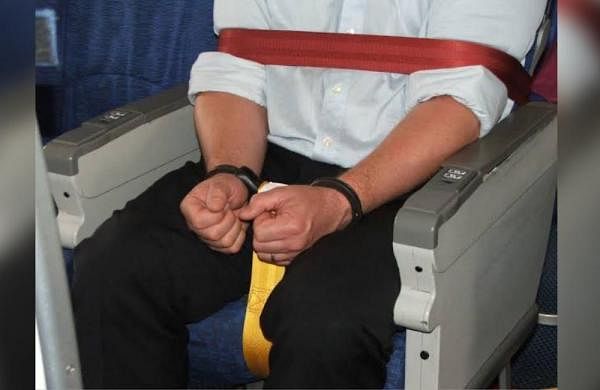Express News Service
NEW DELHI: The recent episodes of unruly Indian passengers on board flights headed to India have left people flummoxed. The Directorate General of Civil Aviation (DGCA) recently pointed out that airlines should use restraining devices to handle unruly passengers.
These restraining devices look like hand-cuffs and the DGCA guidelines state that they must be kept in the aircraft cabin to diffuse situations getting out of control. However, barring Air Asia India most airlines in India haven’t begun to keep them in their cabin yet.
“It is the responsibility of the cabin crew for handling unruly passengers and diffusing a critical situation until it becomes clear that there is no way to resolve it through verbal communication and written notice to the passenger. Applying restraining devices should be used when all conciliatory approaches have been exhausted,” according to the DGCA.
Amongst all the Indian operating airlines, Air Asia India is the only airline that has these restraining devices. Although Air India said they followed the DGCA guidelines in totality, they refrained from commenting on whether or not they keep these restraining devices in the aircraft cabin. SpiceJet and GO First too refrained from responding on the same.
“In adherence to the protocols established by the regulatory body, we deploy a number of measures to ensure the well-being of our guests and crew on board. One such measure is the provision of restraining devices such as zip-tie handcuffs on all our aircraft.
These devices are deployed as a last resort after required warnings are given as per the laid down process and only in the event that a passenger exhibits unruly behaviour and poses a threat to the safety and well-being of the other passengers and crew.
The use of zip-tie handcuffs allows for swift and efficient control of the situation while minimizing the risk of injury to the individual being restrained,” according to an Air Asia India (AIX Connect) spokesperson.
It is possible that with the recent incidents being highlighted and the DGCA pulling up airlines and cabin crew for failing to handle unruly passengers that these devices would be kept as an emergency measure by airlines across India.
“We would in fact go a step further and reach out to those people who can manufacture these devices locally as it would be easy for the airlines to source them,” said an official from the aviation ministry.
Two years back, in August 2021, a 22-year-old passenger onboard Frontier Airlines in the US was duct taped after he inappropriately touched two female flight attendants. He was taped till the aircraft landed. More recently, this year a Virgin Atlantic pilot, flying in Australia, came out of his cockpit and physically removed a passenger after he refused to stop misbehaving with the flight crew.
Pilots and cabin crew in India should take a cue and ensure that unruly passengers are managed within the rights they have which will not just help other co-passengers but act as a deterrent for others.
NEW DELHI: The recent episodes of unruly Indian passengers on board flights headed to India have left people flummoxed. The Directorate General of Civil Aviation (DGCA) recently pointed out that airlines should use restraining devices to handle unruly passengers.
These restraining devices look like hand-cuffs and the DGCA guidelines state that they must be kept in the aircraft cabin to diffuse situations getting out of control. However, barring Air Asia India most airlines in India haven’t begun to keep them in their cabin yet.
“It is the responsibility of the cabin crew for handling unruly passengers and diffusing a critical situation until it becomes clear that there is no way to resolve it through verbal communication and written notice to the passenger. Applying restraining devices should be used when all conciliatory approaches have been exhausted,” according to the DGCA.
Amongst all the Indian operating airlines, Air Asia India is the only airline that has these restraining devices. Although Air India said they followed the DGCA guidelines in totality, they refrained from commenting on whether or not they keep these restraining devices in the aircraft cabin. SpiceJet and GO First too refrained from responding on the same.
“In adherence to the protocols established by the regulatory body, we deploy a number of measures to ensure the well-being of our guests and crew on board. One such measure is the provision of restraining devices such as zip-tie handcuffs on all our aircraft.
These devices are deployed as a last resort after required warnings are given as per the laid down process and only in the event that a passenger exhibits unruly behaviour and poses a threat to the safety and well-being of the other passengers and crew.
The use of zip-tie handcuffs allows for swift and efficient control of the situation while minimizing the risk of injury to the individual being restrained,” according to an Air Asia India (AIX Connect) spokesperson.
It is possible that with the recent incidents being highlighted and the DGCA pulling up airlines and cabin crew for failing to handle unruly passengers that these devices would be kept as an emergency measure by airlines across India.
“We would in fact go a step further and reach out to those people who can manufacture these devices locally as it would be easy for the airlines to source them,” said an official from the aviation ministry.
Two years back, in August 2021, a 22-year-old passenger onboard Frontier Airlines in the US was duct taped after he inappropriately touched two female flight attendants. He was taped till the aircraft landed. More recently, this year a Virgin Atlantic pilot, flying in Australia, came out of his cockpit and physically removed a passenger after he refused to stop misbehaving with the flight crew.
Pilots and cabin crew in India should take a cue and ensure that unruly passengers are managed within the rights they have which will not just help other co-passengers but act as a deterrent for others.





